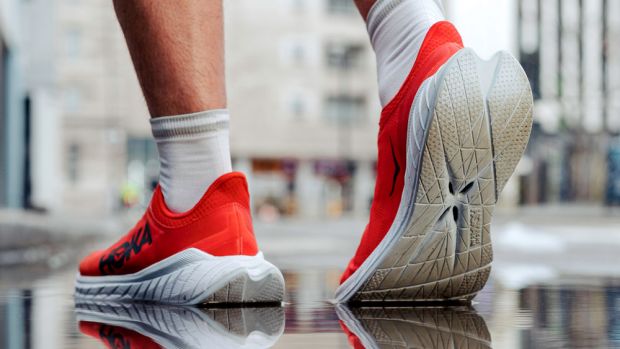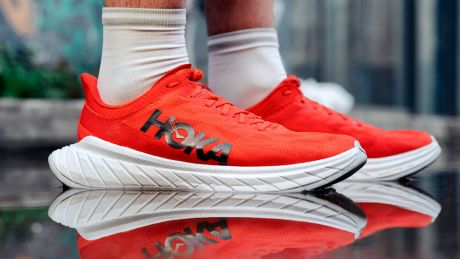Our Verdict
The Carbon X2 lacks the propulsive speed of rival carbon super-shoes, largely because the midsole foam is firm and dull. It might work as a stable racer for ultramarathons, but there are better options available.
For
- Stable for a carbon shoe
- Can handle both training and racing
Against
- Dull ride that lacks bounce
- Extended heel is awkward
- Hoka and others make better carbon shoes
You can trust Coach
If you want a snapshot of how dramatically the running shoe landscape has changed in the past two years, consider the fact that when Hoka’s Carbon X launched in 2019 it was one of just a handful of carbon plate shoes, and the only real competitor to the Nike Vaporfly.
Naturally that benefitted the Carbon X’s popularity, especially as the Vaporfly was very hard to get hold of then, even though it was a very different style of carbon shoe to Nike’s all-conquering racer – firmer, more stable and more durable. You could use it for lots of training and easy running, but it didn’t really come close to matching the performance of the Vaporfly on race day.
The Carbon X2 has launched into a very different environment, one in which almost every brand now offers a carbon plate shoe. The X2 faces stiff competition, not least from Hoka’s own cheaper, lighter Rocket X.
Hoka has made a fair few changes since the X, with mixed results. The most obvious change for the X2 is the swallow heel design, which now extends further back. The intent is to make the ride smoother and more efficient, especially for heelstrikers. This exaggerated heel design is appearing on more and more shoes, but even as a heelstriker myself I remain unconvinced of the promised benefits.

Hoka has also softened the foam in the midsole, and moved the carbon plate further down, making for a less stiff ride compared with the original Carbon X. It’s still not as soft as many carbon shoes like the Nike Vaporfly NEXT%, Adidas Adios Pro or New Balance FuelCell RC Elite, or even the Rocket X, but it’s not unpleasantly harsh.
As with the Carbon X and many Hoka shoes, the X2 has a rocker design to help move you through your footstrike smoothly. The outsole is made from rubberised foam, rather than entirely from rubber, to keep the weight down: this could affect durability, but the original X had the same design and I found it stood up well to a lot of road running.
The X2 is lighter than the first version of the shoe, despite the enlarged heel, weighing 246g in my UK size 9 compared with 258g. I’ve also found it performs better at speed than the original, though it’s less impressive at steady and easy paces.
I’ve done several hard sessions in the X2 along with plenty of easier runs, and it surprised me with how well it handles speed. I logged a 16km run alternating 3min 45sec/km and 3min 25sec/km pace, as well as an interval workout doing 1km reps alternating between 3min 25sec/km and 3min 10sec/km paces.
On the 16km run the shoe felt smooth and stable, if lacking the squish-and-pop feel of something like the Vaporfly. When running the 1km reps the X2 felt good at 3min 25sec/km pace, but when pushing to 3min 10sec/km, which is my 5K pace, it started to feel more awkward.
The X2 didn’t perform as well at easier paces, which is surprising because I did enjoy rolling through long easy and steady runs in its predecessor. The extra foam around the heel makes the X2 seem somehow less nimble than the X, despite being lighter.
I prefer the feel of the Rocket X for every type of run and at £140 it’s cheaper than the X2. Hoka has positioned the Rocket X as more of a short-distance racer, but I’ve found it has the comfort for sustained pacy efforts, and would rate it as a good half marathon and marathon running shoe.
The Carbon X2 also struggles to hold its own in a strong super-shoe field. Notably there is the terrific Saucony Endorphin Speed available for £155 (when in stock), which is a great all-rounder I’ve logged well over 500km of easy runs, fast training and races in.
At £160 the Carbon X2 is cheaper than most of the best carbon racers, though the excellent Adidas Adios Pro is £170 (admittedly it is almost never in stock either). However, the X2 doesn’t get close to the performance of the Nike Vaporfly NEXT% (£240) or Alphafly (£260), and I also rate the Saucony Endorphin Pro (£190) and New Balance FuelCell RC Elite (£210) as better racers, along with the Adios Pro.
It’s not a top-class racer then, and there are better all-rounders available for less money, which leaves the Carbon X2 a little high and dry. It’s a good shoe, but in 2021, you need to be something special to stand out as one of the best carbon plate running shoes.

Nick Harris-Fry is a journalist who has been covering health and fitness since 2015. Nick is an avid runner, covering 70-110km a week, which gives him ample opportunity to test a wide range of running shoes and running gear. He is also the chief tester for fitness trackers and running watches, treadmills and exercise bikes, and workout headphones.

